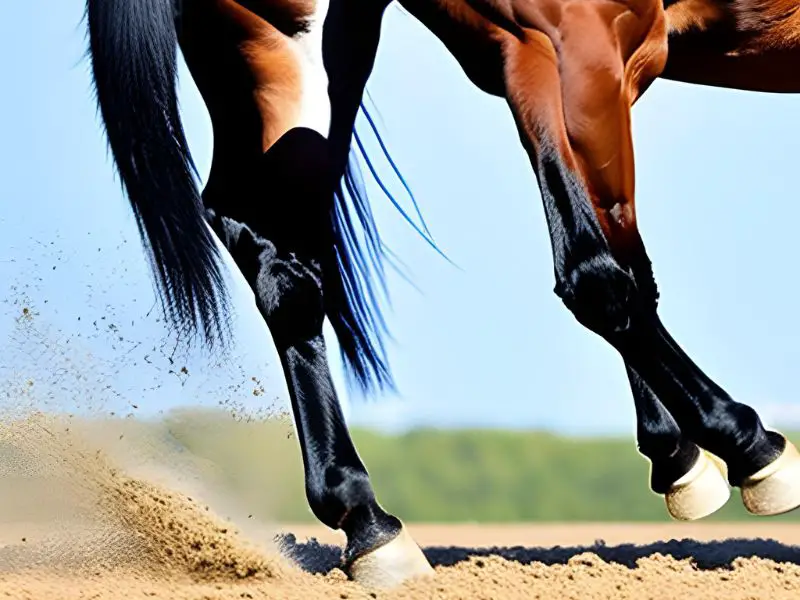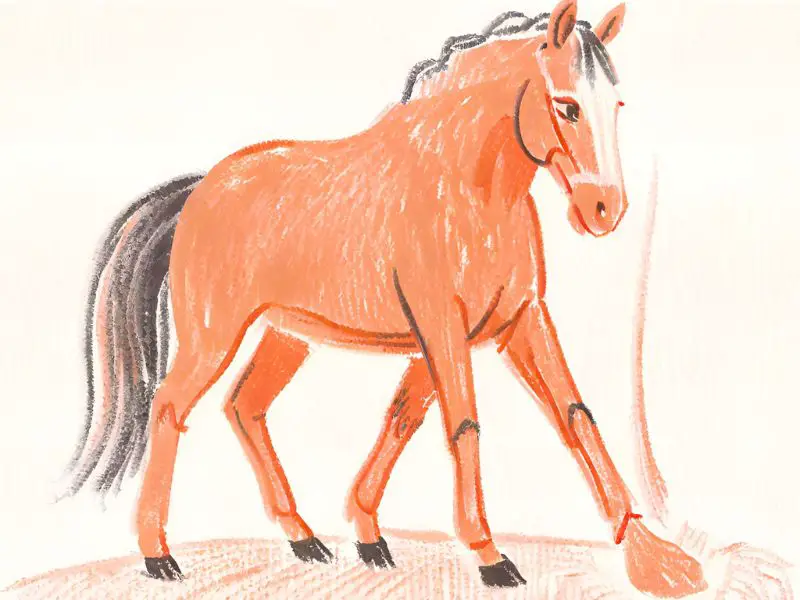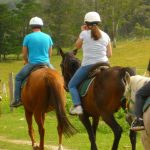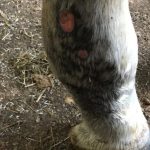How do horses naturally trim hooves? Horses naturally trim their hooves by walking on hard surfaces such as concrete, asphalt, or stone. When a horse walks on these surfaces, the pressure and friction cause the hoof to wear down slowly over time.
This process is known as “natural balance trimming” and helps keep the foot healthy and well-maintained.
The natural angle of the horse’s foot when it lands keeps the toes short while allowing for an even heel-to-toe ratio that prevents excessive pressure from building up in one area of the sole. In addition to walking on hard surfaces, horses can also be seen using their feet to scrape dirt or debris from their hooves, which further helps with maintenance without human intervention.
Horses naturally trim their hooves by wearing them down over time as they walk and graze, which is why regular exercise and turnout are essential for a horse’s health. This natural process helps keep the hoof wall even and smooth, reducing the risk of cracking or splitting. However, it’s important to inspect a horse’s hooves regularly to make sure that this natural wear isn’t excessive, as an overly long or worn-down hoof can lead to medical complications.
If necessary, your farrier can provide additional trimming services to ensure your horse has healthy feet!
Why Do Horses Need Shoes But Not Cows
Horses and cows are hooved animals, but one key difference is that horses require shoes to protect their delicate feet from wear and tear on hard surfaces. Cows, however, do not need shoes because they have harder hooves that can withstand more pressure without needing additional protection. Additionally, cows typically roam grassy fields rather than roads or sidewalks so the extra protection of a shoe isn’t necessary for them.

What Did Horses Do Before Humans Trim Their Hooves?
Before humans began to trim horses’ hooves, the task of keeping them healthy and maintained was left up to Mother Nature. Horses would naturally wear down their hooves as they roamed vast land areas for food and water. This process allowed the horse’s feet to stay balanced and even while avoiding getting too long or overgrown.
While this natural process did help keep their hooves healthy, there were still times when it wasn’t enough on its own, and horses developed issues with overgrowth or infection due to injuries, poor nutrition, or excessively wet conditions. In some cases, this could cause lameness, requiring professional care from a farrier or veterinarian who specialises in treating equine foot problems. Thankfully, today, we have advanced tools and techniques that make trimming horses’ hooves much easier than ever before so that all owners can keep their animals safe and happy!
Why Do Wild Horses Not Need Shoes?
Wild horses have been roaming the earth for centuries and they do not need shoes to protect their feet. This is because of the way that these animals are built. Wild horses have a hardy hoof structure with thick walls, which helps provide protection against rocks and other rough terrain.
Their hooves also expand when they run, meaning that their feet can spread out over a larger area to help them better grip the ground as they gallop across it. In addition, wild horses often live in areas where there is plenty of vegetation, such as grasses and shrubs, providing additional cushioning for their feet while running or walking on trails. Finally, unlike domesticated horses who may be shod due to their lifestyle (i.e., racing or dressage), wild horses typically don’t suffer from any foot problems since they are so adept at navigating difficult terrain without assistance from shoes or other protective gear.
Why Do Horses in Nature Not Need Their Hooves Cut?
Horses in nature do not need their hooves cut because they are able to self-maintain them. In the wild, horses travel over varied terrain that wears down and shapes their hooves naturally. This helps keep them healthy and prevents cracks or other problems from developing.
Furthermore, these terrains provide a source of nutrition for the horse as they graze on natural grasses while travelling which keeps their hoof walls strong and supple. Additionally, using mud is essential for horseshoes in the wild; it gives extra traction when walking on slippery surfaces such as wet stones or muddy grounds during rainy seasons. Finally, living in herds with other horses encourages movement, which is beneficial for keeping your horse’s feet healthy by helping to spread out wear evenly across all four legs instead of one area taking too much pressure at once.
All these advantages mean that horses in nature do not need to have their hooves trimmed like domesticated ones do; allowing them to live more harmoniously with nature and move freely without any hindrance from uncomfortable shoes!
Do Horses Feel Their Hooves Being Trimmed?
Horses are majestic and intelligent animals, so it’s only natural to wonder if they can feel their hooves being trimmed. The answer is yes; horses indeed feel the sensation of having their hooves trimmed, even though they may not always appear uncomfortable or agitated during the process.
This is because horses have sensitive nerve endings in their feet, allowing them to sense pain from external and internal sources.
Even when a horse has had its feet regularly trimmed for years and seems unfazed by the experience, it still experiences some discomfort as its feet are trimmed down.
That said, regular trimming is essential to keeping your horse healthy, as it helps prevent conditions like laminitis, which can lead to more severe health issues down the line.
With this knowledge in mind, owners need to work closely with a trusted farrier who will ensure each trimming session goes smoothly without causing undue stress or discomfort for the horse.
How Do Wild Horses Trim Their Hooves?
Conclusion
Overall, it is essential for the health and comfort of horses that their hooves be trimmed regularly. Horses can naturally wear down their hooves if given enough opportunity to move over hard surfaces like solid ground. However, this should not replace professional trimming from a farrier as needed. Please pay attention to the signs your horse may give you when they need a trim or new shoes; regular maintenance will ensure your horse’s hooves remain healthy and happy!
Janet G Kulick is an experienced horse rider, trainer, and owner of the informative horse blog, Horseray.com. Her engaging writing style and wealth of knowledge on horse care, riding, and training make her a trusted source for horse enthusiasts worldwide.






